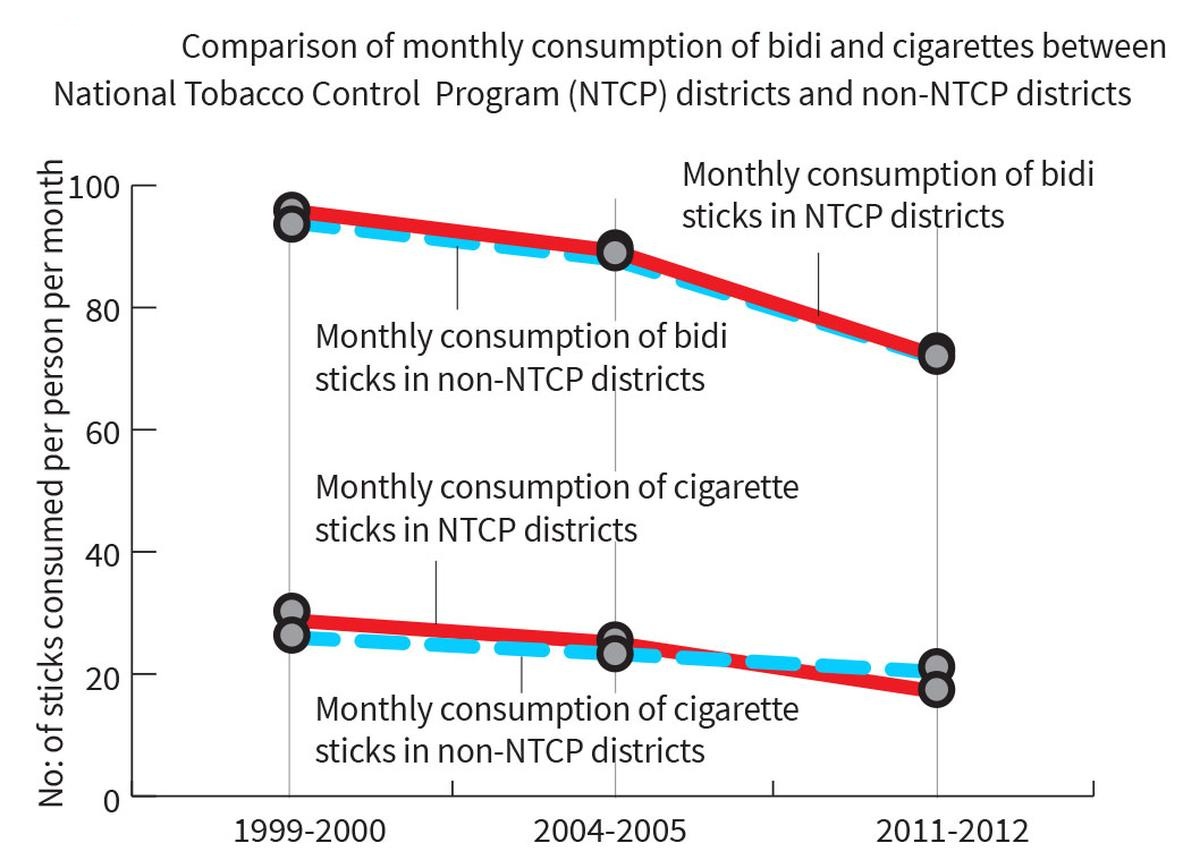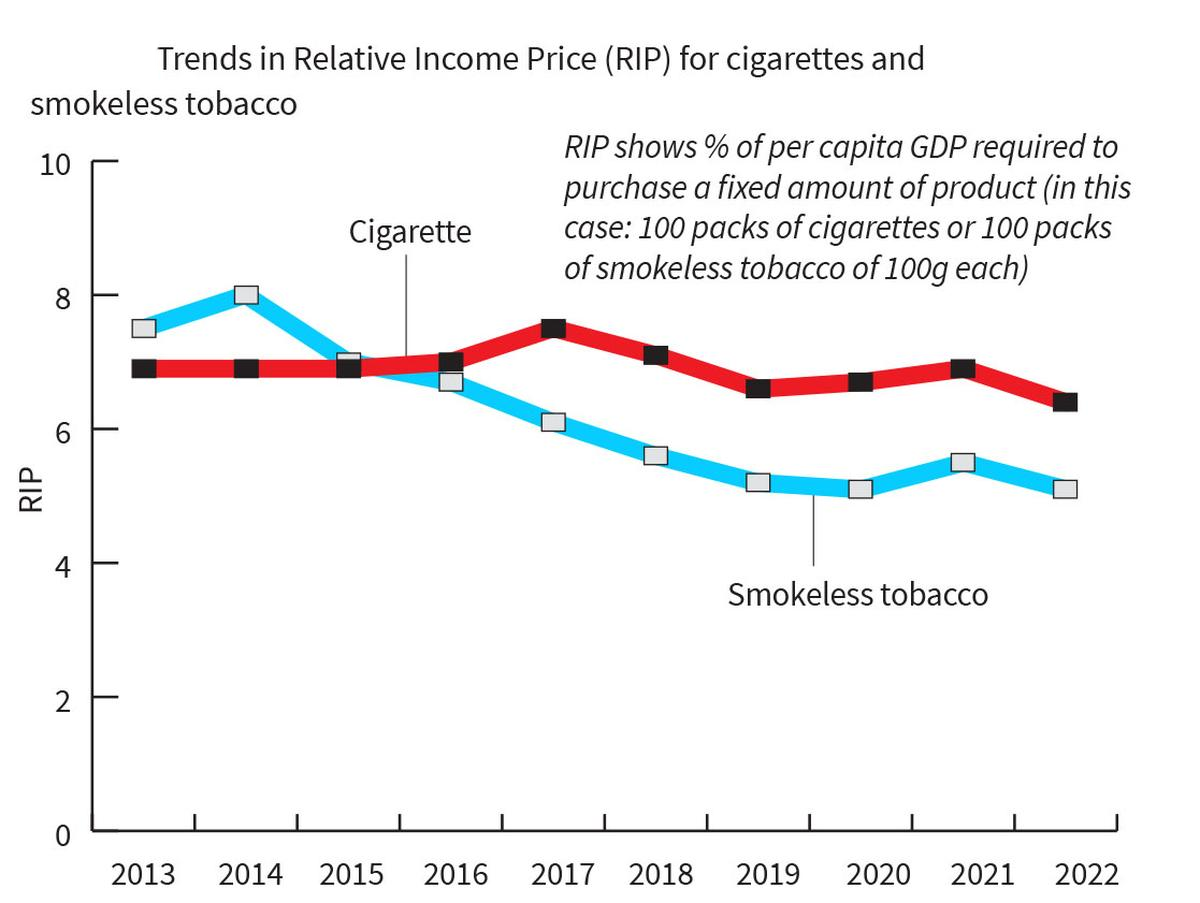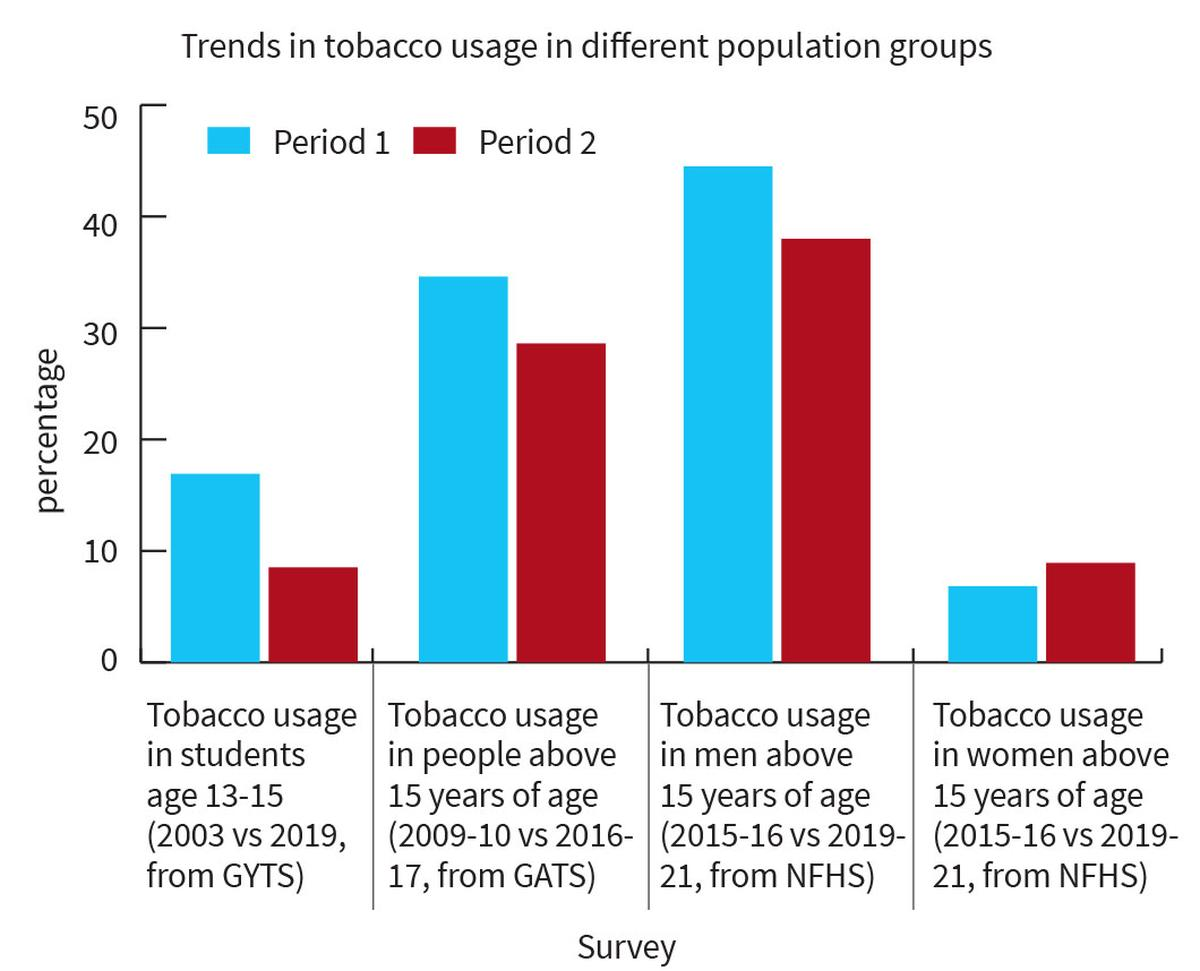Social Issues
Tobacco Epidemic in India
- 31 May 2024
- 12 min read
For Prelims: Tobacco Consumption, Global Youth Tobacco Survey, WHO Framework Convention on Tobacco Control (WHO FCTC), Goods and Services Tax (GST), Cigarettes and Other Tobacco Products Act (COTPA), 2003
For Mains: Impact of tobacco and eradication measures, Scenario of tobacco consumption in India, Taxation of tobacco products, Findings of Global Youth Tobacco Survey.
Why in News?
Tobacco is the most widely recognised preventable cause of disease and death in the world.
- India has the world's second-highest (after China) number of tobacco consumers, with nearly 26 crore people.
Key Facts about Tobacco Usage
- Tobacco kills up to half of its users who don’t quit.
- Tobacco kills more than 8 million people each year, including an estimated 1.3 million non-smokers who are exposed to second-hand smoke.
- In India, nearly 1.35 million die every year due to use of tobacco.
- Around 80% of the world's 1.3 billion tobacco users live in low- and middle-income countries.
- In 2020, 22.3% of the world’s population used tobacco
What are the Statistics About Tobacco Consumption in India?
- No Significant Decrease of Bidi or Cigarette Consumption: As per National Family Health Survey (NFHS) there is no significant difference in the reduction of bidi or cigarette consumption between National Tobacco Control Programme (NTCP) and non-NTCP districts.
- Possible reasons for this may be insufficient staffing, resource allocation, and utilisation, and lack of effective monitoring mechanisms.
- Cigarettes and Bidis Have Become More Affordable: In the past 10 years, cigarettes, bidis, and smokeless tobacco products (SLTs) have become cheaper.
- Goods and Services Tax (GST) system has made them even more affordable due to integrated tax system which lowered the prices.
- Tobacco Use Higher Among Womens: Tobacco use has declined in all groups, except for women where use increased by 2.1% between 2015 and 2021.
World No Tobacco Day:
- World No Tobacco Day is observed on 31st May.
- World No Tobacco Day was created in 1987 by the Member States of the World Health Organization to draw global attention to the tobacco epidemic and its consequences.
- The day aims to inform the public about the dangers of using tobacco.
- It also encourages people around the world to claim their right to health and healthy living and to protect future generations.
- Theme for 2024: “Protecting Children from Tobacco Industry Interference”
- The day serves as a reminder of the preventable death and disease caused by tobacco use, and highlights the importance of tobacco control policies and interventions.
Ahilyabai Holkwar:
- 31st May also commemorates the birth anniversary of Queen Ahilyabai Holkar. Ahilyabai Holkwar was born on 31st May 1725, in the village of Chondi, Ahmednagar district, Maharashtra.
- In 1733, she married Khanderao Holkar, the son of Malhar Rao Holkar, the founder of the Holkar dynasty of the Maratha Empire.
- She became the ruler of the Malwa kingdom after her husband's death in 1754.
- She contributed to the construction of many temples, including the famous Kashi Vishwanath Temple in Varanasi.
- She abolished the practice of Sati in her kingdom and promoted education and women's rights.
- Ahilyabai Holkar died on 13th August 1795.
How is India Fighting Against Tobacco?
- International Commitment:
- WHO Framework Convention on Tobacco Control (FCTC):
- India is one of the 182 signatories of this Convention, which signifies its commitment to global tobacco control efforts.
- It aims to reduce tobacco usage worldwide by helping countries develop demand and supply reduction strategies and effective national tobacco control policies.
- World No Tobacco Day:
- 31st May is observed as ‘World No Tobacco Day’ every year to spread awareness around the deadly effects of tobacco consumption.
- WHO Framework Convention on Tobacco Control (FCTC):
- National Legislation:
- Cigarettes and Other Tobacco Products (Prohibition of Advertisement and Regulation of Trade and Commerce, Production, Supply, and Distribution) Act (COTPA) 2003: It governs different aspects of tobacco, such as production and supply, advertising and promotion, distribution and sale, as well as packaging and labeling.
- National Tobacco Control Program (NTCP) 2007: To strengthen COTPA implementation and FCTC compliance. It’s key functions includes
- Public Awareness Campaigns: Mass media campaigns educate the public about the health risks of tobacco use.
- Smoking Cessation Initiatives: Through quitlines, counselling, and behavioural interventions.
- Enforcement Mechanisms: Enforcement of COTPA provisions with the help of designated authorities.
- The Prohibition of Electronic Cigarette Act (PECA), 2019: It has banned e-cigarettes in India.
- National Tobacco Quitline Services (NTQLS):
- mCessation Programme: Initiative for tobacco cessation by mobile technology.
- Launched in 2016 as part of the government’s Digital India initiative.
- Tobacco Taxation:
- India taxes tobacco heavily, with cigarettes at 53% of retail price. Bidis, a cheaper option, are taxed much lower at 16%. Public health experts want higher bidi taxes to discourage use and raise government revenue.
What are Hidden Costs of Tobacco Beyond Health Risks?
- Soil Depletion: Tobacco rapidly depletes soil nutrients, requiring more fertilisers which further harm soil quality.
- Deforestation: Tobacco production contributes to deforestation, requiring significant wood for processing. Up to 5.4 kg of wood is required to process 1 kg of tobacco.
- Waste Generation: Production and consumption of tobacco creates a massive waste burden (1.7 lakh tonnes annually in India).
- Economic Burden: Tobacco use leads to immense healthcare costs (estimated Rs.1.7 lakh crore loss in India, 2017-18) exceeding the national health budget (Rs 48,000 crore).
- Over 6 million people working in the tobacco industry are at risk due to tobacco absorption through the skin, leading to potential health issues.
- Waste Management Cost: Cleaning up tobacco waste is a significant additional cost (estimated Rs.6,367 crore annually in India).
What are Challenges to Effective Tobacco Control in India?
- Non-compliant Products: Smokeless tobacco (like gutkha) and smuggled products avoid COTPA (Cigarettes and Other Tobacco Products Act) regulations, making it harder to control their production, sale, and marketing.
- Weak Fines: Low fines (eg: maximum fine of only Rs. 5,000 for violating packaging restrictions for the first time) for COTPA violations (not updated since 2003) don't act as a strong enough deterrent for violators.
- Surrogate Advertising: Tobacco companies cleverly use advertisements for other products (like elaichi) to indirectly promote their brands, making it difficult to regulate their marketing reach. These advertisements indirectly promote tobacco use.
- The ICC Men’s Cricket World Cup 2023 displayed surrogate advertisements for at least two tobacco brands.
- Stalled Amendments: The Indian government hasn't passed proposed amendments to strengthen COTPA in 2015 and 2020, which could have addressed these gaps.
- Limited Enforcement Capacity: The National Tobacco Control Programme (NTCP) lacks the staff, resources, and proper monitoring systems to fully implement COTPA across the country.
- Effective Lobbying in Tobacco Industry:
- E-cigarettes are banned, but problem persist: Policy (banning e-cigarettes) isn't being fully enforced.
- Tax breaks for Small Tobacco Companies: The government isn't taxing all tobacco products equally, making it cheaper for some people to buy harmful products.
- Conflict of Interest with Government: It raises concerns about government's commitment to tobacco control.
- Central government holds a 7.8% stake in ITC Ltd., India’s largest tobacco company.
Way Forward
- Needs Strong Foundation: India's Cigarettes and Other Tobacco Products Act (COTPA) and National Tobacco Control Programme (NTCP) need to be updated for tobacco control efforts.
- Higher tobacco taxes: Taxes on tobacco products, especially bidis and smokeless tobacco, are well below the recommended WHO target of 75%. Increasing taxes would discourage consumption and generate revenue for public health initiatives.
- Effective Monitoring: Regular monitoring is essential to track trends in tobacco use, identify areas where COTPA is being violated, and assess the effectiveness of anti-tobacco campaigns.
- Supporting Tobacco Farmers: Introduce public programs to help tobacco farmers transition to alternative crops. This would minimise the economic hardship caused by reduced tobacco cultivation.
- Data-Driven Approach: Timely collection of data on tobacco use patterns is crucial to understand how these patterns are changing and to identify new strategies employed by the tobacco industry. This data is vital for formulating effective tobacco control policies.
|
Drishti Mains Question: Discuss the impact of tobacco consumption in India. Also, highlight the challenges faced in regulating tobacco products and the significance of global frameworks. |
UPSC Civil Services Examination, Previous Year Questions (PYQs)
Prelims:
Q. Consider the following: (2012)
- Assessment of land revenue based on nature of the soil and the quality of crops
- Use of mobile cannons in warfare
- Cultivation of tobacco and red chillies
Which of the above was/were introduced into India by the English?
(a) 1 only
(b) 1 and 2
(c) 2 and 3
(d) None
Ans: (d)
Q. Match List-I with List-II and select the correct answer using the code given below the Lists: (2008)
| List-I(Board) | List-II (Headquarters) |
| A. Coffee Board | 1. Bengaluru |
| B Rubber Board | 2. Guntur |
| C Tea Board | 3. Kottayam |
| D Tobacco Board | 4. Kolkata |
Code: A B C D
(a) 2 4 3 1
(b) 1 3 4 2
(c) 2 3 4 1
(d) 1 4 3 2
Ans: (b)
Q. Which of the following are the reasons/factors for exposure to benzene pollution? (2020)
- Automobile exhaust
- Tobacco smoke
- Wood burning
- Using varnished wooden furniture
- Using products made of polyurethane
Select the correct answer using the code given below:
(a) 1, 2 and 3 only
(b) 2 and 4 only
(c) 1, 3 and 4 only
(d) 1, 2, 3, 4 and 5
Ans: (a)
Q2. Which one of the following groups of plants was domesticated in the ‘New World’ and introduced into the ‘Old World’? (2019)
(a) Tobacco, cocoa and rubber
(b) Tobacco, cotton and rubber
(c) Cotton, coffee and sugarcane
(d) Rubber, coffee and wheat
Ans: (a)







